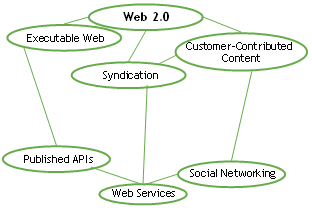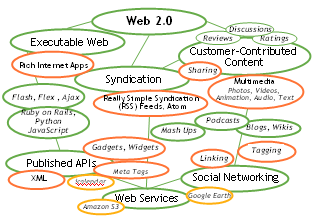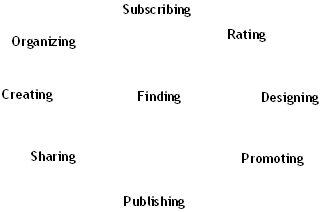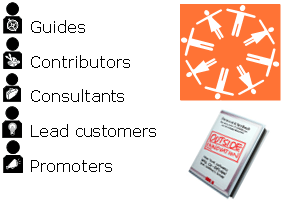B2B Firms Are Adopting Web 2.0
How to Engage and Empower Business Customers Online
Web 2.0 concepts are more than just conceptual at this point. Savvy B2B companies are taking advantage of new technologies to offer tools that promote customer innovation. Our B2B use of Web 2.0 chalk talk provides “slideware” with commentary so that you can re-use the graphics, concepts, and overall presentation to educate others.
NETTING IT OUT
Most of the buzz around Web 2.0 has focused on consumer-oriented Web sites. Less attention has been paid to the many firms whose audiences are business professionals. This “chalk talk” is an annotated presentation that offers patterns and examples of Web 2.0 in action in the B2B world. You are welcome to download and reuse any of the slides.1
WEB 2.0 IS THE CURRENT WEB ETHOS
I view the Web 2.0 phenomenon 2 as 1) a natural evolution of Web technologies and 2) a way to open up your site to empower customers to shape your content and offerings to better meet their collective needs.
What Are the Patterns of Web 2.0?

© 2008 Patricia Seybold Group Inc.
Illus. 1. The six enabling capabilities of Web 2.0 provide a rich interactive playground for customers.
What Are the Patterns of Web 2.0?

© 2008 Patricia Seybold Group Inc.
Illus. 2. Some of the services and technologies that comprise the Web 2.0 ecosystem.
SIX ENABLING CAPABILITIES.
The key enablers for empowering customers and partners to roll up their sleeves, interact, and contribute are:
- Executable Web. The use of rich Internet applications (Ajax, Flash, Flex) using browser-independent programming languages (JavaScript, Python, Ruby on Rails) to deliver interactive applications.
- Customer-Contributed Content. The provision for visitors and customers to contribute their own perspectives through ratings, reviews, discussions, wikis, and, increasingly, videos.
- Social Networking. The ability for users to share tags (interests), profiles, links, and to find others with common interests or needed expertise.
- Syndication. The ability for users to post content on one site (e.g., Flickr or YouTube) and publish it on many other sites (your company’s site, their blog). And the ability for users to subscribe to changes and updates via RSS.
- Published APIs. This syndication is enabled through open interfaces, mostly written in human-readable XML, which makes it easy for moderately technical users to modify and/or combine two or more services to create “mash ups”—a Google map with geo-coded photographs, for example.
- Web Services. Many organizations (Amazon, Google, Yahoo!, FedEx, UPS, etc. have leveraged these open APIs to provide (usually free) utility services each of which can answer a specific request (where’s my package, order this book, map this location, post this on my calendar). Gadgets and Widgets package Web Services into interactive templates (usually created using JavaScript and XML) that end-users can customize and syndicate onto their own desktops, Web sites, blogs, or hand-held devices.
HOW DO BUSINESS CUSTOMERS USE WEB 2.0?
Many of the early adopters of Web 2.0 technologies were consumer-oriented Web sites like Flickr, MySpace, YouTube, and SecondLife. Business people who looked at the frenzied participatory activity on these sites saw people with a lot of time on their hands. They assumed that busy business people wouldn’t care to invest their time in tinkering online. They were wrong.
What Are Business Customers Doing??

© 2008 Patricia Seybold Group Inc.
Illus. 3. How do business customers want to interact on a business Web site?
Common Activities
For business users, most scenarios start with finding the information or product they’re seeking. Once they’ve landed in the right place, they want to interact with it in order to accomplish their objective (learn, explore, solve a problem, find resources, decide, buy, upgrade, renew, discover new approaches). On Web 2.0-enabled sites, business visitors will rate products, read and write reviews, organize and tag information in order to find it again, share their tags and their needs, and even design new solutions or publish their research findings, promoting your brand as they do so.
Typical Roles
Given a conducive environment, customers who identify closely with your brand (your brand fits some aspect of their self-image) will play one or more of these roles:
- Guides. Guides classify, organize and filter your content. They rate alternatives. They act as advisors to other customers, solving problems and offering insights.
- Contributors. Contributors are happy to invest time in creating reviews. They create and share tools (checklists), video how to’s, application notes, programming code, and work-arounds.
- Consultants. Consultants are subject matter experts who provide deep insights about important applications. They offer valuable product or process improvement suggestions.
- Lead Customers. Lead customers push the envelope in applying your products and services in unexpected ways to meet their specialized needs. They can help you innovate and discover new markets and applications if you harvest their insights.
- Promoters. Promoters are enthusiasts about your brand and your products. They’re happy to spread the word to the rest of the world. They’re promoting themselves as they promote your brand.
5 Roles Customers Naturally Play

© 2008 Patricia Seybold Group Inc.
Illus. 4. In my book, Outside Innovation , 3 I identified five roles that customers naturally want to play vis à vis a company or brand they care about.
Nature Publishing Group Engages Scientists in Classifying and Linking Info
Howard Ratner, CTO of the Nature Publishing Group, created a tagging and sharing utility targeted to readers of life sciences-related information—that found on Nature.com and elsewhere. Scientists and researchers tag articles with the current terminology in the fields they follow. Through RSS feeds, they can subscribe to updates so that they’ll be alerted to any article that anyone tags as pertinent to the topic they’re tracking (AIDS, gene expression, etc.)...
**FOOTNOTES**
1) http://www.slideshare.net/pseybold/using-web-20-for-outside-i-nnovation-seybold-stm-dec-07/
2) Tim O’Reilly coined this term. See “Web 2.0 Principles and Best Practices,” by John Musser with Tim O’Reilly and the O’Reilly Radar Team, November 2006, p. 13, http://www.oreilly.com/radar/web2report.csp , or, “What is Web 2.0: Design Patterns and Business Models for the Next Generation of Software,” by
Tim O’Reilly, September 30, 2005, http://www.oreillynet.com/pub/a/oreilly/tim/news/2005/09/30/what-is-web-20.html
3) http://www.customers.com/books_oi.aspx
**FOOTNOTES**
Sign in to download the full article
0 comments
Be the first one to comment.



